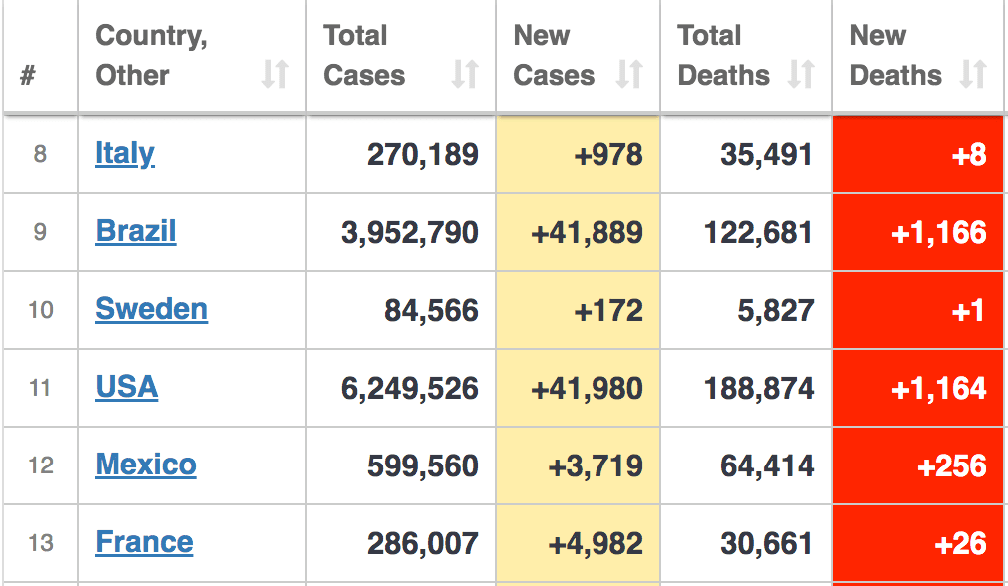What is the Most Important Variable in A Country’s Success Versus the Corona Virus?
Executive Summary
- The public of most countries has been told that their countries need to lockdown, social distance, and use masks.
- What is the evidence for the effectiveness of the current status quo Coronavirus response?

Introduction
In the US, the government and media have been adamant in asserting that wearing masks, social distancing, and locking down is an effective strategy for addressing the coronavirus. Lockdowns have been in effect in the US since March, roughly 7 months ago. Since roughly June, masks have increasingly been mandated. Employees at establishments have been directed to approach patrons with masks below their noses to tell them to push the mask over the nose. The conventional wisdom is now that people that are socially responsible wear masks.
We now have the passage of a number of months, and we can compare and contrast which countries have been more negatively impacted by the coronavirus and which countries have followed which approaches to respond to the coronavirus.
See our references for this article and related articles at this link.
Evidence for the Effectiveness of Masks
This video, published in February 2020, several months before the US Government changed its position on masks, explains that only some masks do much to stop a person from getting the coronavirus. Masks like the N95. The N95 must have a seal, so it must be measured for the face so that there is a seal, and one N95 mask won’t necessarily work for any given person as one model won’t necessarily fit any one person’s face.
However, almost none of the population has an N95 mask, and most of the population is using masks like surgical masks and cloth masks. There is no evidence for these types of masks are effective. Yet, there is no effort by the US Government to get N95 masks out to the public. A person entering an establishment can get by with just about anything, including a bandana.
The MD in this video states that.
I think people see a mask and they see an illusion of protection. Anyone who does not have a respitory illness, a cough or a sneezing, should not be wearing any type of mask. Whether it is a surgical mask or a respirator.
People do not use their masks correctly. They play with it, they use it too long, they rub their nose underneath it.
The following is a comment on this video.
4 months later, there is no new data to support masks yet now, they are the most important thing to wear. Why is that? I still don’t get it. And not only are real masks being recommended, but any old rag across your face is supposed to stop covid in its tracks.
Yet, months after this video was made, the US Government abruptly switched lanes and began recommending masks.
Comparing Countries with Different Strategies Versus the Coronavirus
The US is often listed as the top country for coronavirus — however, this is misleading because the statistic most frequently communicated is total corona cases or total corona deaths. The most important statistic is not the total number of corona cases or total corona deaths but the incidence of cases and deaths, which divides the total numbers by the population.
Once one sorts the World O Meter statistics by incidence, not the total number of cases, the US ranks as the 11th worst-hit country for coronavirus worldwide. As we will see further in the article, there is a good reason for the US’s position, and it is most likely not the reason that is often given.
Important Consideration Which Reduces Comparability
There is a built-in bias to the statistics because the developed world maintains far better health statistics than the undeveloped or developing world. Just looking at a table won’t tell you this. It needs to be interpreted by stories from different countries.
- For example, India, which for months had a strangely low incidence of coronavirus, now has fast-growing numbers. But this is related to the increase in testing.
- China claims a ridiculous 4,600 coronavirus deaths, which is contradicted by multiple sources, so no statistics from China are reliable.
The countries ranked close to the US tell an interesting story, which media entities don’t appear to be picking up.

The mortality per 1 M population ranges from 584 for Italy to 470 for France. The US is sandwiched between Sweden and Mexico. Let us look at these two countries.
Mexico
Mexico is a country that is known as a country that decided not to respond to coronavirus, with the Mexican government going so far as to tell its citizens “not to be afraid of touching.” On the other hand, Mexico has unreliable statistics and have administered very few coronavirus tests.
I found this quote from a comment on a New York Times article.
As someone who knows doctors working in the hospitals in Mexico City I can tell you that they are told they can only put cause of death as COVID on a limited number of death certificates each day in order to keep the numbers down.
Therefore, due to a lack of testing, coronavirus statistical fraud, and the non-measurement of many Mexicans that die at home, Mexico is not a good comparison country to the US.
All indicators are that Mexico if its statistics were maintained correctly, would have one of the highest incidences of coronavirus deaths in the world.
However, as will be covered further in the article, this is unlikely to be because Mexico has been so lax in response to coronavirus (not mandating masks, not locking down the economy, etc..) but because of Mexico’s high rate of obesity and lower than average health of its citizens versus other countries.
Sweden
Sweden is one of the best-known countries in the world for its divergent strategy regarding coronavirus. Sweden has minimally locked down, and the Swedish Government does not recommend wearing masks. It is accepted that the general population is expected to be exposed to coronavirus, and the vulnerable groups (those with pre-existing conditions and old) are told to self-isolate.
Sweden’s strategy is based upon the reality of the coronavirus, that it spreads very easily but is only dangerous to a small and known percentage of the population.
Anders Tegnell, Sweden’s State Epidemiologist, has stated there is no evidence of masks’ effectiveness in stopping the spread of coronavirus. Notice the street images of Sweden in this video are almost devoid of mask usage. Sweden has been pilloried in international media for this policy.
As stated in the video, countries that also mandated masks were France, Spain, Greece, and Italy. However, Spain and Italy have a higher incidence of coronavirus cases and deaths than the US. On the other hand, Greece is very low, the 110th worst-hit country.
These countries, and others, appear to indicate little relationship between the use of masks and the incidence of coronavirus in countries. Yet, this easily observed relationship is almost nowhere in the coverage of coronavirus.
Observe the following video from CNN.
Why did CNN only compare Sweden’s mortality to its neighbors? Should the US’s coronavirus incidence only be compared to its neighbors — so Canada and Mexico? This appears to be designed not to look across larger data, but at a restricted data set. This is called cherry-picking or excluding data to tell the story you intend to tell. CNN does not explain why Sweden’s coronavirus incidence should not be compared against all developed countries (that have reasonably reliable statistics).
The CNN interviewer intends to push the discussion to focus only on Sweden’s immediate neighbors. However, Dr. Tegnell points out to Christiane Amanpour that the neighbors of Sweden have a lower population density than Sweden. Sweden’s city of Stockholm is significantly larger than Olso, Helsinki, etc. (I checked this, and it was true). Dr. Tegnell also proposes that how mortality is recorded is more stringent in Sweden than in most other countries, increasing the comparability of coronavirus statistics.
And where did most of the deaths occur in Sweden? In the long term, care (i.e., old people homes). How would a general lockdown have impacted these deaths?
There is no attempt to review each country’s approaches and determine which have been effective. Is it truly lost on CNN that there is no relationship between masks mandated in countries and their incidence of coronavirus? Is that a relationship CNN is not interested in exploring?
If so, why not?
This is the “analysis” provided by CNN. Cherry-picked data and preconceived notions. CNN’s health coverage seems to match its political coverage. They are known to be in the tank for one US political party and the US intelligence community, and they rig the data points to support these agendas.